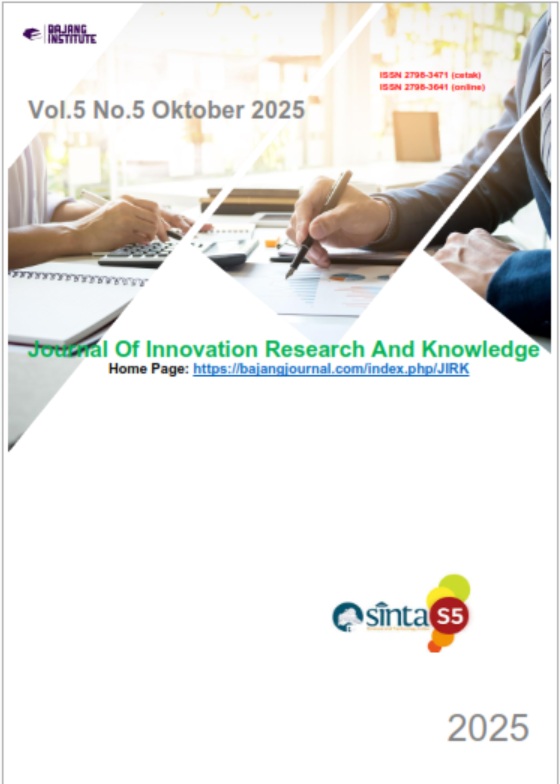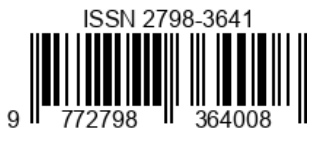ANALISIS KUALITAS CITRA DIGITAL RADIOGRAPHY ABDOMEN NON-KONTRAS BERDASARKAN NILAI SNR DAN CNR DENGAN TEKNIK PENGOLAHAN CITRA PHYTON
Keywords:
Signal to Noise Ratio (SNR), Contrast to Noise Ratio (CNR), Non-Contrast Abdomen, Python Image Processing, Image EnhancementAbstract
Background: Non-contrast abdominal radiography is an important diagnostic procedure in radiology for detecting abnormalities in the abdominal organs. Image quality is evaluated through the Signal-to-Noise Ratio (SNR) and Contrast-to-Noise Ratio (CNR) to measure the signal-tonoise ratio and the ability to distinguish contrast between anatomical structures. Image processing using Python allows for improved image quality at low exposures, in line with the ALARA (As Low As Reasonably Achievable) principle of minimizing radiation dose without compromising diagnostic accuracy. However, studies on optimizing non-contrast abdominal images using this technique are still limited, particularly in reducing the effects of scattered radiation on thick objects such as the abdomen. Methods: This study employed a quantitative experimental approach. An adult abdominal phantom was used. The study was conducted in the Radiology Laboratory of Universitas ‘Aisyiyah Yogyakarta, from March 2025 to May 2025. Data collection was conducted through documentation and processing using Python on Google Colab. The SNR and CNR values of noncontrast abdominal images before and after image enhancement were calculated using Non-Local Means (NLM) and Histogram Equalization (HE). The Shapiro-Wilk normality test and paired sample t-test were then performed. Results: The calculated SNR value increased from an average of 8.73 to 11.66, and the CNR increased from an average of 1.69 to 4.28. The data were normally distributed (p>0.05), and there was a significant difference in SNR (p=0.0019) and CNR (p=0.0003) before and after enhancement (p<0.05). Conclusion: Based on the results of this study, image processing using Python effectively improves the quality of non-contrast abdominal radiographic images at low exposures, supporting diagnostic accuracy and reducing radiation dose.
References
Ahishakiye, E., Van Gijzen, M. B., Tumwiine, J., Wario, R., & Obungoloch, J. (2021). A survey on deep learning in medical image reconstruction. Intelligent Medicine, 1(3), 118–127. https://doi.org/https://doi.org/10.1016/j.imed.2021.03.003
Albrecht, M. H., Scholtz, J.-E., Kraft, J., Bauer, R. W., Kaup, M., Dewes, P., Bucher, A. M., Burck, I., Wagenblast, J., Lehnert, T., Kerl, J. M., Vogl, T. J., & Wichmann, J. L. (2015). Assessment of an Advanced Monoenergetic Reconstruction Technique in Dual-Energy Computed Tomography of Head and Neck Cancer. European Radiology, 25(8), 2493–2501. https://doi.org/10.1007/s00330-015-3627-1
Asriningrum, S., Ansory, K., & Hasan, P. T. (2021). Faktor Eksposi terhadap Kualitas Citra Radiografi dan Dosis Pasien Menggunakan Parameter Penilaian Signal to Noise Ratio (SNR) pada Pemeriksaan Thorax Posteroanterior dengan Menggunakan Pesawat Computed Radiografi. Jurnal Imejing Diagnostik (JImeD), 7(1), 15–18. https://doi.org/10.31983/jimed.v7i1.6650
Astria, R. (2024). Analisis Kualitas Citra Radiografi Cr Dengan Signal To Noise Ratio (Snr) Dan Contras To Noise Ratio (Cnr) Menggunakan Microdicom. Interdisciplinary Journal of MedTech and EcoEngineering (IJME) DOI, 1(1), 1–9.
Auliana, S., Janah, M. N., Dwiki, G., & Aryono, P. (2024). KLIK: Kajian Ilmiah Informatika dan Komputer Multi-Domain Medical Image Enhancement Through Fuzzy and Regression Neural Network Approach. Media Online), 4(6), 2733–2743. https://doi.org/10.30865/klik.v4i6.1875
Azmi Anugrah, N., dan Nurul Fuadi Jurusan Fisika, S., Sains dan Teknologi, F., & Alauddin Makassar, U. (2018). Pengukuran Entrasce Skin Exposure Dan Laju Paparan Radiasi Hambur Pada Pemeriksaan Kepala Dengan Metode Tegangan Tinggi Di Rumah Sakit Bhayangkara Makassar. JFT. No. 1, 5(1), 62–71.
Fauziah, E., Bagus Sadewo, F., Putra, H. M., Rosyani, P., & Komputer, F. I. (2024). Penerapan Image Processing Menggunakan OpenCV dan Python untuk Memperhalus Gambar Melalui Smoothing Image dengan Metode Gaussian Blur. Indonesian Journal of Networking and Security (IJNS), 13(2), 1–7. https://ijns.org/journal/index.php/ijns/article/view/1838
Fuadi, N., Jusli, N., & Harmini. (2022). Pemantauan Dosis Perorangan Menggunakan Thermoluminescence Dosimeter (Tld) Di Wilayah Papua Dan Papua Barat Tahun 2020-2021. Jurnal Sains Fisika, 2(1), 63–74. http://journal.uin-alauddin.ac.id/index.php/sainfis
Gong, Y., Qiu, H., Liu, X., Yang, Y., & Zhu, M. (2024). Research and Application of Deep Learning in Medical Image Reconstruction and Enhancement. 7(3).
Gouillart, E., Iglesias, J. N., & Walt, S. Van Der. (2016). Analyzing microtomography data with Python and the scikit ‑ image library. Advanced Structural and Chemical Imaging. https://doi.org/10.1186/s40679-016-0031-0
Huda, W., & Abrahams, R. B. (2015). X-Ray-Based Medical Imaging and Resolution. American Journal of Roentgenology, 204(4), W393–W397. https://doi.org/10.2214/AJR.14.13126
Kempski, K. M., Graham, M. T., Gubbi, M. R., Palmer, T., & Lediju Bell, M. A. (2020). Application of the generalized contrast-to-noise ratio to assess photoacoustic image quality. Biomedical Optics Express, 11(7), 3684–3698. https://doi.org/10.1364/BOE.391026
Kumar, N., Verma, R., Sharma, S., Bhargava, S., Vahadane, A., & Sethi, A. (2017). A Dataset and a Technique for Generalized Nuclear Segmentation for Computational Pathology. IEEE Transactions on Medical Imaging, 36(7), 1550–1560. https://doi.org/10.1109/TMI.2017.2677499
Lampignano, J. P., & Kendrick, L. E. (2018). Bontrager’s Textbook of Radiographic Positioning and Related Anatomy. Elsevier. https://books.google.co.id/books?id=SOr_vQAACAAJ
Li, W., Diao, K., Wen, Y., Shuai, T., You, Y., Zhao, J., Liao, K., Lu, C., Yu, J., He, Y., & Li, Z. (2022). High-strength deep learning
image reconstruction in coronary CT angiography at 70-kVp tube voltage significantly improves image quality and reduces both radiation and contrast doses. European Radiology, 32(5), 2912–2920. https://doi.org/10.1007/s00330-021-08424-5
Long, B. W., Rollins, J. H., & Smith, B. J. (2015). Merrill’s Atlas of Radiographic Positioning and Procedures: 3-Volume Set. Elsevier Health Sciences. https://books.google.co.id/books?id=K8eNCgAAQBAJ
Maulana, A., Auliatunnajah, F., Rosidin, N., Ramadien Rizki Darmawan, M., & Rosyani, P. (2024). Implementasi OpenCV dengan Metode Image Thresholding pada Gambar. Jurnal Artificial Inteligent Dan Sistem Penunjang Keputusan, 2(1), 27–32. https://jurnalmahasiswa.com/index.php/aidanspk
Nurvan, H., Wardani, A. K., & Palupi, N. E. (2023). Karakteristik Pemeriksaan Pasien Di Instalasi Radiologi Rumah Sakit Ananda Babelan Bekasi Periode Agustus 2021–Juli 2022: Studi Retrospektif. Jurnal Pandu Husada, 4(4), 1–14.
Patel, S., P, B. K., & Muthu, R. K. (2020). Medical Image Enhancement Using Histogram Processing and Feature Extraction for Cancer Classification. http://arxiv.org/abs/2003.06615
Rahmat, Y., Melani Gustia, R., & Salim, A. (2022). ANALISIS SEBARAN RADIASI HAMBUR PESAWAT SINAR X KONVENSIONAL DI INSTALASI RADIOLOGI RSIA ZAINAB. Medical Imaging and Radiation Protection Research (MIROR) Journal, 2(1 SE-Articles), 1–6. https://doi.org/10.54973/miror.v2i1.206
Tian, Z., Qu, P., Li, J., Yukun, S., Li, G., Liang, Z., & Zhang, W. (2023). A Survey of Deep Learning-Based Low-Light Image Enhancement. Sensors, 23, 7763. https://doi.org/10.3390/s23187763
Zhang, H., Zeng, D., Zhang, H., Wang, J., Liang, Z., & Ma, J. (2017). Applications of nonlocal means algorithm in low-dose X-ray CT image processing and reconstruction: A review. Medical Physics, 44(3), 1168–1185. https://doi.org/10.1002/MP.12097















